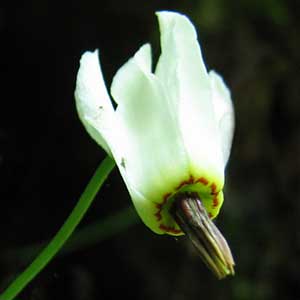Dodecatheon dentatum
Primulaceae
dentate shooting star, tooth American cowslip, white shooting star
primrose family
not obvious at anthesis, or sometimes erect to slightly horizontal, slender;
roots white or reddish;
bulblets absent.
sometimes inflated (Hottonia).
(3.5–)8–20(–30) × (1–)2.5–6(–7) cm;
petiole slightly winged;
blade ovate, base decurrent onto stem, abruptly tapering to petiole, margins subentire to sinuate or crenate, surfaces glabrous.
in basal rosettes (cauline and alternate, opposite, or whorled in Hottonia), simple (pinnately compound in Hottonia);
stipules absent;
petiole present or absent;
blade margins entire, denticulate, ciliolate, or crenulate.
(1–)2–5(–11)-flowered;
bracts lanceolate, 1.5–5(–8) mm, glabrous.
terminal, scapose or sessile umbels or solitary flowers;
bracts usually present.
0.8–5 cm, glabrous.
calyx light green, 4–6 mm, glabrous, tube 2–3.5 mm, lobes 5, 1.5–3(–4) mm;
corolla tube yellow with red, thin, wavy ring, lobes 5, white, 7–18(–20) mm;
filaments distinct, maroon to black, 0.1–0.5 mm;
anthers (4.5–)5–7.5 mm;
pollen sacs maroon to black, connective dark purple to maroon, smooth;
stigma not enlarged compared to style.
bisexual, homostylous or heterostylous (Hottonia, Primula);
perianth and androecium hypogynous;
sepals 4–5, connate proximally into tube;
petals 4–5, connate proximally, corolla campanulate to salverform or tubular with long or short tube;
nectaries absent or sometimes nectariferous hairs present;
stamens 5, antipetalous, epipetalous, distinct or connate proximally;
anthers opening by longitudinal slits;
staminodes absent;
pistils 1, 5-carpellate;
ovary superior, 1-locular;
placentation free-central with ± globose central axis;
ovules anatropous, bitegmic, not embedded in placentae, tenuinucellate;
styles 1, terminal;
stigmas 1, usually capitate (rarely truncate).
capsular, dehiscence valvate or operculate.
pale greenish to tannish, dark yellow apically, valvate, narrowly ovoid, (6–)8–11 × 3–5 mm, glabrous;
walls thin, pliable.
without membrane along edges.
1–200+, brown or black, angular or rounded, (rarely with eliasomes in some Primula);
embryo straight;
endosperm copious, starchless.
or perennial (rarely biennial) herbs (suffrutescent in some Primula), sometimes somewhat succulent (Androsace), sometimes rhizomatous (Primula), sometimes stoloniferous (Primula), sometimes with glandular hairs producing crystalline substance that forms farinose coating (Primula);
resin canals sometimes present (Hottonia).
= 44.
Dodecatheon dentatum
Primulaceae
Dodecatheon dentatum occurs mainly on the eastern slope of the Cascade Range from south-central British Columbia to central Washington, with disjunct populations near the Columbia River in southwestern Washington, the Columbia River Gorge, northeastern Oregon, and northern Idaho. In Idaho, this species occasionally forms hybrids with D. pulchellum var. pulchellum (Oberle 262, MO).
(Discussion copyrighted by Flora of North America; reprinted with permission.)
Genera 20, species ca. 600 (5 genera, 52 species in the flora).
The largest genera in Primulaceae are Primula (ca. 500 species) and Androsace (ca. 100 species). No genera are endemic to the flora area; Dodecatheon and Douglasia have relatively few representatives elsewhere (northeastern Asia).
The family contains ornamental taxa, especially in Dodecatheon and Primula. Primula can cause dermatitis. Some taxa are pollinated by insects; selfing also occurs. Seeds are dispersed by gravity, water, wind, or ants (Primula; B. Ståhl and A. A. Anderberg 2004).
As typically described (e.g., A. Cronquist 1981; V. H. Heywood 1978), Primulaceae were clearly polyphyletic, closely related to Myrsinaceae and Theophrastaceae. M. Källersjö et al. (2000) and B. Ståhl and A. A. Anderberg (2004) removed the nonrosette terrestrial members from Primulaceae in the broad sense and placed them in the Myrsinaceae, which are further distinguished by leaves and calyx often dotted with yellow or dark streaks, flowers with relatively shorter corolla tubes, seeds immersed in placentae, and wood devoid of rays or with multiseriate rays only. Maesa, consisting entirely of trees found in the Eastern Hemisphere tropics, also has semi-inferior ovaries, pedicels with two bracts, and wood with both uniseriate and multiseriate rays; it, too, was removed from Primulaceae/Myrsinaceae and placed in its own family (Källersjö et al.). The families Primulaceae in the narrow sense, Myrsinaceae, Theophrastaceae (including Samolaceae), and Maesaceae then form a monophyletic clade within Ericales (P. F. Stevens, http://www.mobot.org/MOBOT/research/APweb/), sharing some features, most notably flowers with sympetalous corollas, stamens in a single series and opposite the petals, free-central placentation, bitegmic, tenuinucellate ovules, and plants generally with tannins and saponins.
Additional evidence (L. Martins et al. 2003) indicates that Androsace and Primula may not be monophyletic; more work is needed to resolve these issues. The work of M. Källersjö et al. (2000) showed that Douglasia should remain separate from Androsace, and Dodecatheon should remain separate from Primula, although Dodecatheon clearly is derived from Primula subg. Auriculastrum. Alternative views suggesting more inclusive concepts of Primula and Androsace have been offered by I. Trift et al. (2002), A. R. Mast et al. (2004), and G. M. Schneeweiss et al. (2004). The phylogenetic position of Cyclamen, a scapose taxon currently included in Myrsinaceae, has not been resolved. Our understanding of Primulaceae is still in flux, and future taxonomic realignments at the familial and generic levels are to be expected.
(Discussion copyrighted by Flora of North America; reprinted with permission.)
1. Leaves pinnately compound. | Hottonia |
1. Leaves simple | → 2 |
2. Corolla lobes reflexed, lengths 2+ times tube; stamens exserted, anthers connivent. | Dodecatheon |
2. Corolla lobes not reflexed, lengths to 2 times tube; stamens included, anthers not connivent | → 3 |
3. Sepals keeled (at least on tubes), glabrous or stellate-hairy; corollas pink, rose, or purple; plants usually perennial, cushion- or mat-forming | Douglasia |
3. Sepals not keeled or only weakly keeled in fruit, glabrous, pilose, or puberulent; corollas lavender, magenta, pink, purple, rose, violet, white, or yellow; plants annual, biennial, or perennial, usually not cushion- or mat-forming | → 4 |
4. Corollas white, fading to pink, (usually to 5 mm, if 5+ mm, plants hairy); flowers homostylous. | Androsace |
4. Corollas lavender, magenta, pink, purple, rose, violet, yellow, or some- times white, (7+ mm, plants never grayish-pilose); flowers heterostylous or homostylous. | Primula |
- Local floras:
CA,
OR
- Local Web sites:
CalFlora,
CalPhotos,
Flora NW,
PNW Herbaria
WildflowerSearch
iNaturalist (observations)
- LBJ Wildflower Center
- SEINet
- Plants of the World Online
- Encyclopedia of Life
- Wikipedia
- Google Image Search


